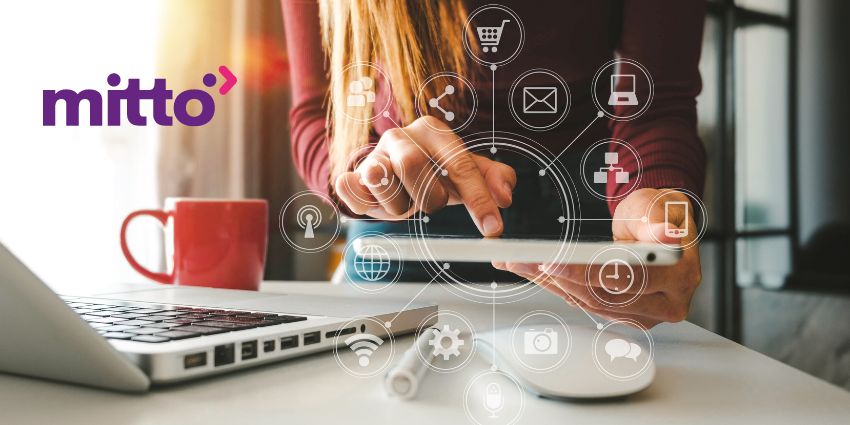Unfortunately, staying ahead of the competition from a CX perspective is often more complicated than it seems.
It’s not enough to simply offer fast, personalized, and effective service. Organizations also need to communicate with their customers throughout the purchasing journey on the channel of their choice. Increasingly, SMS is becoming one of the most popular channels available for service. About 75% of customers under 44 prefer to contact businesses via text or chat apps.
Additionally, leading omnichannel communications provider Mitto found that customers are more likely to purchase based on personalized SMS recommendations than a multi-million dollar Super Bowl campaign.
So, how do companies build SMS into their strategy for sales, service, and marketing?
Step 1: Make SMS Part of a Full Omnichannel Plan
Studies consistently show that messaging-based communications are becoming increasingly popular today, particularly among younger generations.
As consumers in every industry spend more time connected to their phones, SMS offers the perfect opportunity to engage buyers. The right campaigns can help nurture leads, increase conversions, and improve customer retention rates. However, to leverage the most value from an SMS CX strategy, companies can’t simply “add text” into their tech stack.
The best results come from a complete omnichannel campaign, one that effectively aligns all of the communication tools used by customers into one unified environment. According to Mitto’s “State of the Customer Experience” report, companies with an omnichannel strategy are four times more likely to have loyal customers and three times more likely to report significant revenue increases.
With this in mind, companies should be looking for platforms that allow them to connect their SMS strategy to not just other communication tools but also all the resources used to deliver stellar customer experiences.
Step 2: Create a Customer Journey Map
To make the most of the power SMS has to offer in today’s communication landscape, companies need to understand where opportunities exist to interact with consumers via text. While many business leaders are familiar with the benefits of SMS messaging for marketing, the right solutions can be used to interact with customers throughout the entire purchasing journey.
“SMS isn’t a one-trick pony. From acquisition to ongoing loyalty, your brand can message your customers at every step of their journey. Onboarding welcome messages, marketing offers, two-factor authentication to secure their accounts, two-way conversations for support use cases – the list goes on. Don’t limit SMS to just one instance. It’s a powerful tool to keep your customers continually engaged.” – Laura Apel, Senior Vice President of Marketing at Mitto
As well as using carefully crafted and personalized campaigns to capture audience attention, showcase new products, and drive sales, companies can also look at other ways to bring SMS into the CX landscape. For instance, SMS campaigns can be used to:
- Educate and inform customers: Companies can use SMS campaigns to provide customers with information about products and new releases, share insights into business growth, and even provide order status updates and notifications. This allows businesses to stay connected and top-of-mind with their target audience throughout their buyer journey.
- Increase customer retention rates: Not only can SMS strategies keep customers informed, but they can also encourage clients to stick with a business for longer. Companies can use SMS strategies to follow up with customers after they purchase and provide access to helpful content to increase customer success rates. The right tools can even be used to re-engage customers at risk of churning with promotions and personalized offers.
- Provide customer service: SMS offers a quick and easy way for customers to access support and guidance when they don’t want to wait for a customer service agent to answer their call. With SMS messaging, customers can send queries to companies in their own time and access support whenever needed. Companies can even create automated message flows to minimize the need for human agents to handle interactions.
Step 3: Optimize the Messaging Experience
Once businesses have a plan for how they will use SMS in their interactions with customers, the next step is optimizing the experience. Often, this starts with developing a strategy for customer communications. Businesses can create templates and best-practice guidelines for employees to use when sending messages en masse or responding to customers one-on-one.
However, the right tools can make a huge difference to the success of an SMS strategy. SMS and omnichannel messaging platforms give businesses the resources they need to create, manage, and monitor SMS campaigns effectively.
Platforms for SMS messaging can provide businesses with useful tools for creating dynamic, engaging messages, which they can also schedule to be delivered at the perfect time to increase open rates. By integrating SMS API tools with their CRMs, brands can segment lists of contacts based on their preferences, buyer behaviors, or unique needs, allowing for more personalized campaigns.
What’s more, with the right campaign management and SMS tools, businesses can leverage insights from every campaign they send. Reporting and analytics tools can provide a behind-the-scenes view into which messages increase customer loyalty, boost conversions, and drive results.
It’s Time to Capitalize on the Power of SMS
For some time now, customers have been searching for more convenient, comfortable, and efficient ways to communicate with brands. SMS messaging is more cost-effective, faster, and personal than emailing or phone calls. Implementing SMS into a full omnichannel communication strategy allows businesses to leverage a range of benefits.
Not only can the right SMS strategy increase customer engagement levels and boost sales, but it can also reduce churn rates and increase customer lifetime values. The key to success is implementing the right strategy. Finding a CPaaS partner that allows you to leverage SMS and other advanced omnichannel tools is crucial.
The right platform will help businesses create automated campaigns, personalize customer conversations, and use insightful analytics to constantly drive better results.







